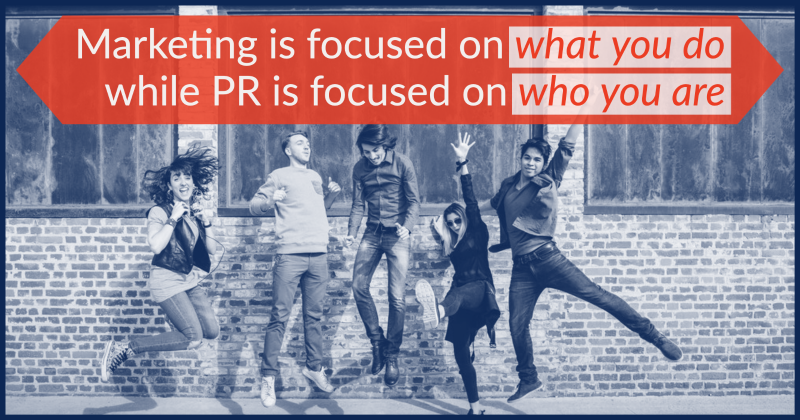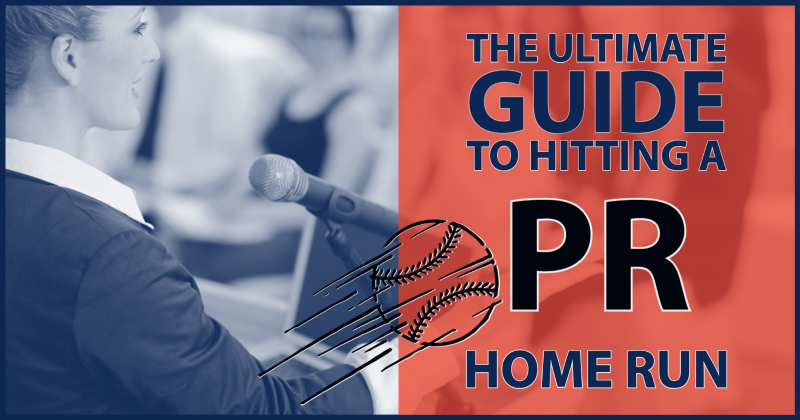If you think back over the past century, a few stellar PR campaigns likely stick out in your mind: the “I Love (Heart) New York” campaign, “Got Milk?”, and Smokey the Bear’s “Only YOU can prevent forest fires”. What makes these slogans so memorable? Or, consider the brands we’ve deemed as some of the most successful and beloved in American history: Coca-Cola, McDonald’s, Wal-Mart. How did these corporate superstars garner such strong loyalty amongst consumers?
The simple answer: they implemented Major League-level public relations strategies in conjunction with top-notch marketing techniques.
Regardless of your industry, competition in the 21st century is fierce. The landscape for businesses both large and small is saturated, and the playing field can feel wildly uneven, particularly for brands just entering the scene. How can a rookie coming up from the Minors stand a chance against the likes of superstar pitchers like Jacob deGrom or Gerrit Cole? In PR terms, to hit a “home run,” it’s all about owning your message and using the techniques we’ll discuss below to spread the word.
What Is PR and Why Is It Important?
Public relations, or PR, establishes how a brand communicates with consumers and the general public. It defines how the company’s message is spread, and in the 21st century, it’s more important than ever. Why? Because today’s media landscape is vast, with messaging coming from so many different channels – from television, print, podcasts, and every corner of the internet. Consumers can easily become overwhelmed by the influx of promotional material. On top of that, consumers are savvier than ever, and they value transparency and authenticity.
As inspirational speaker Simon Sinek put it, “People don’t buy what you do; they buy why you do it. If you talk about what you believe, you will attract those who believe what you believe.” Ultimately, consumers don’t buy products; they buy brands, and nothing fosters trust and loyalty between a brand and consumers quite like public relations. PR spreads your message, ingrains it in the public’s conscience, and when executed properly, can boost a business’s reputation and bottom line.

Public relations can be broken down into three main categories: owned, paid, and earned. Below, we’ve outlined the types of media assets that fall into these categories.
Owned:
- Blog posts
- Website content
- Newsletters
- Social media posts
Owned media should be your starting point as these assets set the tone for the rest of your PR campaign. They are also completely in your control, making owned media a go-to tactic for nearly all brands.
Paid:
- Advertising, including Pay-Per-Click (PPC)
- Sponsored posts
- Influencer marketing
Paid media – paying media outlets to make your content visible – should be your next step. This includes buying ad space, investing in Google Ads and social media advertising, writing sponsored blog posts for relevant industry websites, and collaborating with social media influencers.
Earned:
- News mentions
- Reviews
- Praise, shares, and mentions on social media
- Search engine rankings
Earned media is the most difficult type of asset to obtain, but arguably the most influential as it validates your position as an authority or trusted brand in your industry. Earned media is ultimately achieved through word of mouth and is not easily manipulated. Just as it can boost your reputation, it requires that your brand already have some level of established reputation to reach the eyes and ears of media outlets in the first place.
We recommend building a strong PR foundation through owned media techniques and then boosting that content with paid strategies, achieving enough visibility to be picked up organically by media outlets, leading to earned media. Of course, you can also earn attention by establishing healthy, symbiotic relationships with journalists and customers and optimizing your website for search engines. We will discuss these techniques in more detail later on.
What’s the Difference Between Public Relations and Marketing?
It’s no secret that PR and marketing go hand-in-hand. However, the strategies used, their direct impact on your business’s success, and their goals are slightly different. The primary goal of public relations is to boost your brand’s reputation – it’s about recognition, sentiment, and visibility. Marketing, on the other hand, is intended to promote products or services and drive sales. Both are about communicating your brand’s value; however, marketing is focused on what you do while PR is focused on who you are.

Who you are and what you do are both essential messages that must be clearly communicated to grow your business and establish loyalty amongst your customers. As mentioned above, consumers want to give their business to a brand they know and trust.
They also want to do business with a brand they need. That’s where marketing comes in – a strong marketing campaign identifies the target audience’s pain points and presents an undeniable solution. It establishes what a company does to solve a problem.
Public relations is less concerned with the what and concentrates on the why. Why choose this particular brand to solve your problem? How you connect with the public and how the public perceives you will answer that question.
Knock It Out of the Park With These 6 PR Strategies
How can you implement a Major League-level PR campaign? Digital marketing expert Neil Patel suggests rethinking everything you thought you knew about public relations. In fact, he recommends adopting a human relations mindset, saying, “A public relations pro has coverage and favorable public image in mind; but after all is said and done, what are they left with? On the flip side, a human relations pro works hard for meaningful, social relations that provide value and create long-lasting relationships.
In other words, a successful campaign will focus on relationship-building and open communication. Rather than blasting out your message at high volume, purposefully and thoughtfully begin a dialogue. Choose your channels wisely and engage your audience on a more human level.
Below, we’ve outlined some of our top strategies to create a strong PR campaign.
Create Killer Content
As we briefly touched on above, publishing a steady stream of content on your own, controlled channels is the best way to begin your PR campaign. Producing “owned media” gets the conversation going and provides you with a collection of content you can use to promote your brand and demonstrate your value to external media channels. The key to creating killer content that boosts your PR strategy is to move the focus away from your company’s products and services. It can be tempting to pump up the promotional content in an effort to drive sales, but remember: that is not the point of public relations. Concentrate on sharing your story and publishing content that engages your audience, whether that’s through blog articles, social media posts, or videos.
Step Up Your SEO
Yes, SEO is technically in the realm of digital marketing, which we’ve already defined as separate from public relations. However, we also know that PR and digital marketing go hand-in-hand. In order to spread your message and gain the proper media attention, you’ll need to increase your visibility online. On the most basic level, make sure your site is user-friendly, in line with your branding, and is optimized for the right keywords. Using tools like SEMrush, Ahrefs, or Moz, you should be able to identify any glaring errors or opportunities for improvement.
Attend Industry Events
Industry events are great opportunities to gain exposure for your brand, targeting your ideal audience. Whether you host an event or attend a larger, industry-wide one, these functions grant you the opportunity to have facetime with prospective customers and solidify your relationship with current ones. And as a cherry on top, these events are often covered by relevant media outlets, making your participation a great way to get your name out there.
Connect With the Community
Public relations involves community relations, which is essentially building strong relationships with your local community. This could be through charity work, special discounts for a target demographic, collaboration with other businesses or municipalities, or anything else that engages your city, town, or neighborhood and boosts customer loyalty.
Boost Your Employer Brand
Also known as internal PR, employee relations is another critical aspect of public relations. By cultivating a positive employee perception of your business, you create a strong employer brand, which can go a long way toward boosting your overall image. Believe it or not, potential customers do care about your values and how you treat your employees. Some even take the extra step of reading your Glassdoor reviews. When job satisfaction is high, it creates a buzz. Happy employees will advocate for your business and also lead to happy customers.
Gain Positive Exposure Through Media Relations
As we mentioned above, public relations should be about human relations, and while the media can feel cold and less-than-human sometimes, journalists are people, too! Media relations is best performed by building positive relationships with journalists and news outlets. You’ll want to write press releases, schedule interviews, and keep the media apprised of your most recent and noteworthy events, updates, and milestones.
Finally, you’ll need to keep the momentum going. PR is an ongoing, iterative process; it is not a task to mark off your checklist. Why? Because in the grand scheme of things, media coverage is brief and fleeting. That’s the nature of the news cycle: your story is outdated the moment it reaches your audience. In the time it takes to publish a review or a blog post, the market has already shifted and the media space has already been flooded with content. Continuous, strategic outreach and content creation are key to keeping your brand top of mind.

Measure Success With These Public Relations KPIs
So, you’ve started your PR campaign; how do you know if it’s working? Let’s walk through some of the most important key performance indicators that will help you determine whether you’re about to hit a home run or hit the bench.
Brand Mentions and Sentiment
Any time your business is mentioned by name in news coverage, blog posts, reviews, or on social media, you’ve earned a brand mention. This metric is critical to track because it helps you measure the scope of awareness surrounding your brand. However, you must keep in mind that the old adage “any press is good press” does not apply when we’re talking about PR. The context of these brand mentions is key; that’s where the idea of sentiment comes in. In the PR world, there is such a thing as bad publicity. The idea is to create a positive public opinion of your brand, so keep an eye out for scathing reviews or negative news angles. Ultimately, tracking sentiment will alert you to how your audience feels about your brand and whether or not you need to address any issues.
Conversions
We’ve said this before, but it bears repeating: an increase in sales is not the primary goal of a PR campaign; it’s all about brand awareness. However, if you are seeing a boost in your customer acquisition and revenue, chances are you’re doing something right. The best way to determine if your increased conversions are a result of your PR campaign is to simply ask new customers how they heard about you. Another method is to use an online tool like Google Analytics to gain insight into your customers’ conversion paths.
Traffic
Site traffic and conversions are often closely linked. An increase in website visitors may be a clear sign of successful PR efforts. After all, if customers are learning about your company through earned media (news, blogs, or any sort of word of mouth) and then visiting your site, your PR strategy is working nicely. Again, survey your customers to find out how they heard about your brand and track their referral paths to see which media outlets are performing best for you. This will help you determine where to increase your PR efforts, and perhaps, where to cut back.
Social Engagement and Shares
Social engagement and social shares are two slightly different metrics. Social engagement refers to incoming views, impressions, likes, and comments. How many people have seen or interacted with your social media posts? Social shares, on the other hand, involve your audience sharing something from your blog or website on their own social media feed. Both of these social media metrics are critical to understanding what your audience finds valuable. Once you’ve got an understanding of what your customers enjoy most about your brand, you can work on creating more of that type of content and ensuring it reaches as many eyes as possible.
Rounding the Bases and Bringing It Home
In this guide, we’ve covered the importance of public relations, how PR differs from marketing, our top tips for starting your PR campaign, and how to measure success. If you’re just starting out, remember: even home run record-holder Barry Bonds didn’t knock it out of the park his first time at bat. Like baseball, PR takes training, patience, and dedication. If you want to play in the big leagues, begin by implementing some of the strategies above. And keep in mind, you’ll need your team behind you every step of the way. That’s where Angry Apples comes in. Our dedicated team of digital marketing and PR experts works with you from the very beginning to build online cross-platform PR campaigns with one purpose: to grow your brand.

